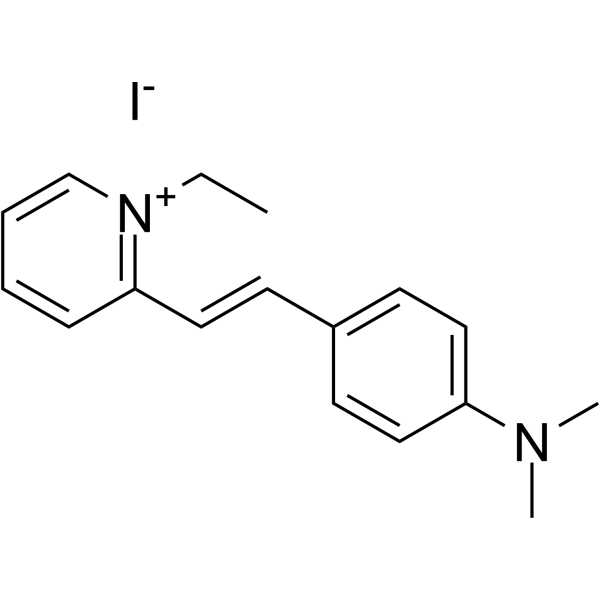2-(4-dimethylaminostyryl)-1-ethylpyridinium iodide

2-(4-dimethylaminostyryl)-1-ethylpyridinium iodide structure
|
Common Name | 2-(4-dimethylaminostyryl)-1-ethylpyridinium iodide | ||
|---|---|---|---|---|
| CAS Number | 3785-01-1 | Molecular Weight | 380.26700 | |
| Density | N/A | Boiling Point | N/A | |
| Molecular Formula | C17H21IN2 | Melting Point | 267ºC (dec.)(lit.) | |
| MSDS | Chinese USA | Flash Point | N/A | |
| Symbol |

GHS07 |
Signal Word | Warning | |
|
In silico activity profiling reveals the mechanism of action of antimalarials discovered in a high-throughput screen.
Proc. Natl. Acad. Sci. U. S. A. 105 , 9059-64, (2008) The growing resistance to current first-line antimalarial drugs represents a major health challenge. To facilitate the discovery of new antimalarials, we have implemented an efficient and robust high-throughput cell-based screen (1,536-well format) based on p... |
|
|
Imaging of Plasmodium liver stages to drive next-generation antimalarial drug discovery.
Science 334 , 1372-7, (2011) Most malaria drug development focuses on parasite stages detected in red blood cells, even though, to achieve eradication, next-generation drugs active against both erythrocytic and exo-erythrocytic forms would be preferable. We applied a multifactorial appro... |
|
|
The role of efflux systems and the cell envelope in fluorescence changes of the lipophilic cation 2-(4-dimethylaminostyryl)-1-ethylpyridinium in Escherichia coli.
Biochim. Biophys. Acta 1278(2) , 205-12, (1996) The interaction of the fluorescent dye 2-(4-dimethylaminostyryl)-1-ethlypyridinium cation (DMP+) with cells of Escherichia coli AN120 (uncA) and AS-1 (acrA) was studied to elucidate the role of the envelope and of efflux systems in the uptake of lipophilic ca... |
|
|
The phosphonium ion efflux system of Escherichia coli: relationship to the ethidium efflux system and energetic studies.
J. Gen. Microbiol. 132(11) , 3187-93, (1986) The extent of accumulation of methyltriphenylphosphonium ion by Escherichia coli was shown to be dependent on the permeability of the outer membrane and the activity of an efflux system for this compound. Evidence consistent with the operation of a single eff... |
|
|
Transient hyperpolarization of yeast by glucose and ethanol.
Biochim. Biophys. Acta 936(3) , 421-8, (1988) At pH 7, addition of glucose under anaerobic conditions to a suspension of the yeast Saccharomyces cerevisiae causes both a transient hyperpolarization and a transient net efflux of K+ from the cells. Hyperpolarization shows a peak at about 3 min and a net K+... |
|
|
The apical sensory organ of a gastropod veliger is a receptor for settlement cues.
Biol. Bull. 198(1) , 67-76, (2000) On the basis of anatomy and larval behavior, the apical sensory organ (ASO) of gastropod veliger larvae has been implicated as the site of perception of cues for settlement and metamorphosis. Until now, there have been no experimental data to support this hyp... |
|
|
Use of fluorescence probes to monitor function of the subunit proteins of the MexA-MexB-oprM drug extrusion machinery in Pseudomonas aeruginosa.
J. Biol. Chem. 272(35) , 21964-9, (1997) The MexA-MexB-OprM efflux pump of Pseudomonas aeruginosa consists of two inner membrane proteins, MexA and MexB, and one outer membrane protein, OprM. We investigated the role of the components of this drug extrusion system by evaluating the repercussions of ... |
|
|
Development of a no-wash assay for mitochondrial membrane potential using the styryl dye DASPEI.
J. Biomol. Screen. 15(9) , 1071-81, (2010) Mitochondrial dysfunction is a hallmark of several diseases and may also result from drugs with unwanted side effects on mitochondrial biochemistry. The mitochondrial membrane potential is a good indicator of mitochondrial function. Here, the authors have dev... |
|
|
Cellular and subcellular structure of anterior sensory pathways in Phestilla sibogae (Gastropoda, Nudibranchia).
J. Comp. Neurol. 403(1) , 39-52, (1999) Two sensory-cell types, subepithelial sensory cells (SSCs) and intraepithelial sensory cells (ISCs), were identified in the anterior sensory organs (ASO: pairs of rhinophores and oral tentacles, and the anterior field formed by the oral plate and cephalic shi... |
|
|
Mitochondria-rich cell activity in the yolk-sac membrane of tilapia (Oreochromis mossambicus) larvae acclimatized to different ambient chloride levels.
J. Exp. Biol. 207(Pt 8) , 1335-44, (2004) Mitochondria-rich cells (MRCs) in the yolk-sac membrane of tilapia (Oreochromis mossambicus) larvae were examined by Na+/K(+)-ATPase immunocytochemistry and vital staining for glycoproteins following acclimation to high (7.5-7.9 mmol l(-1)), normal (0.48-0.52... |